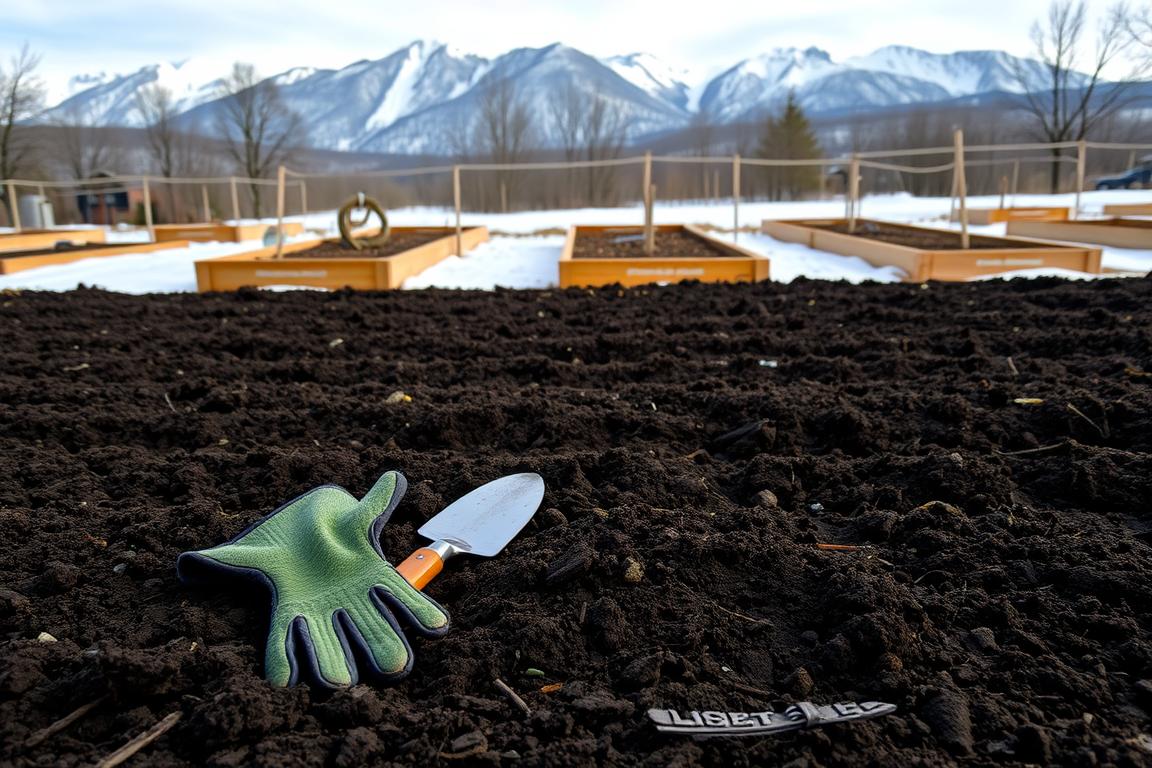Keeping your houseplants happy and healthy is key to a thriving indoor garden. This guide covers all you need to know about caring for your house plants. It includes tips on light, water, pests, and growing conditions. Whether you’re new to plants or have a green thumb, you’ll find expert advice to help your plants thrive.
Key Takeaways
- Proper watering is crucial, as overwatering is the leading cause of houseplant death.
- Sunlight requirements vary greatly among different indoor plant species.
- Maintaining optimal humidity levels is essential for tropical and subtropical houseplants.
- Fertilizing sparingly in winter and using a balanced fertilizer is recommended for most houseplants.
- Regular monitoring and prompt treatment are key to preventing and controlling common houseplant pests.
Understanding Your Houseplant's Light Requirements
Caring for indoor plants means knowing their light needs. Houseplants need different amounts of light, from bright sunlight to low light. Finding the right light level is key to helping your plants grow well.
Identifying Light Levels for Different Plants
Tropical plants can’t handle direct sun for long. Cacti and succulents love bright sunlight. Different plants need various light types, like direct, filtered, reflected, and sky light. Most houseplants do best in bright, indirect light.
To check your home’s light, use a light meter. A reading of 50-150 foot-candles means low light, good for plants like snake plants and pothos. For tropical plants, readings of 200-800 foot-candles are best.
Using Artificial Lighting for Indoor Plants
If your home lacks enough natural light, artificial lighting can help. LED “grow” bulbs mimic sunlight and help plants photosynthesize. High-light plants need 6+ hours of sun, while others need less.
Knowing your plants’ light needs helps you create the best environment. With the right mix of natural and artificial light, your plants will grow strong and healthy.
Mastering the Art of Watering Your Houseplants
Proper watering is key to keeping your houseplants healthy and thriving. Overwatering is a common mistake that can lead to dead plants. By learning when and how to water your plants, you can keep them lush and vibrant.
When to Water Your Plants
Don’t just water your plants on a set schedule. Check the soil moisture level of each plant. The top inch or two should be dry before watering again. This depends on the plant type, pot size, and the environment.
Watch for signs of under or overwatering like wilting, dryness, or yellowing leaves. This will help you know when to water.
Proper Watering Techniques
- Use room temperature water and avoid cold water, which can shock the plant.
- Pour the water slowly around the base of the plant, allowing it to fully saturate the soil until it starts draining out the bottom.
- Let the excess water fully drain away, as sitting in waterlogged soil can lead to root rot.
- Consider bottom watering, where you submerge the entire pot in water, allowing the plant to absorb moisture from the bottom up.
By understanding your plants’ watering needs and using the right techniques, you’ll master houseplant care. With practice, your indoor garden will thrive and stay vibrant.
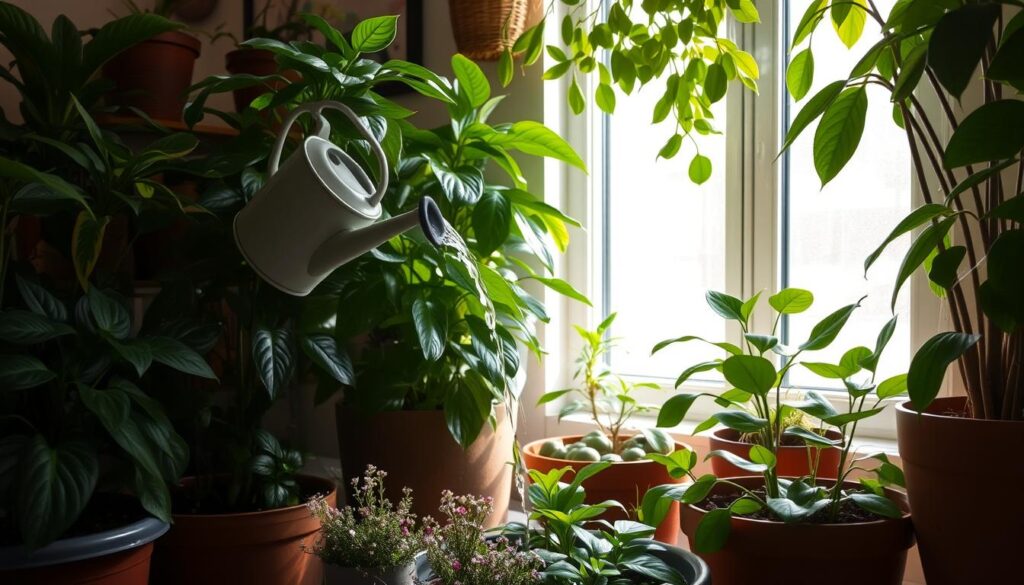
“Overwatering, rather than underwatering, is a common mistake made by houseplant keepers,” notes Dr. Leonard Perry, a horticulture expert.
Maintaining Optimal Humidity for Your Indoor Plants
As a passionate gardener, I’ve learned that the right humidity is key for my indoor plants. Many houseplants come from tropical areas with high humidity. They need more moisture than the dry air in most homes, especially in winter.
The Mayo Clinic suggests keeping humidity at 30% to 50% for plants to grow well. But, some plants need up to 60% humidity or more. Plants with thin leaves often need more moisture than those with thick, waxy leaves.
To increase humidity, you can use a humidifier or group plants together. Wet pebble trays, glass domes, frequent misting, and double potting with damp moss also work well.
Watch for signs like shriveled leaves or browning edges to know when your plants need more moisture. High humidity can cause mold or fungal infections, leading to yellow leaves from overwatering.
Keeping the right humidity, 40-60% higher than usual, is key for your plants’ health. In dry months, a humidifier helps your plants and you. But, avoid misting plants with fuzzy leaves to prevent disease.
With these tips, you can create a great indoor garden for your houseplants. A bit of extra care with humidity can greatly improve your indoor garden.
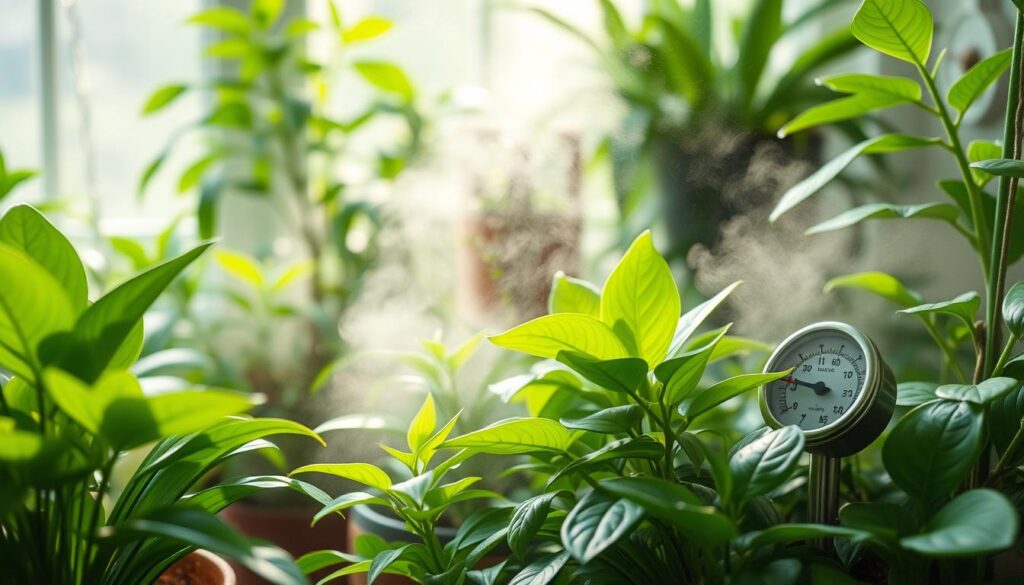
| Humidity Level | Recommended for |
|---|---|
| 30-50% | Optimal for most houseplants |
| 60% or higher | Humidity-sensitive plants |
By following these simple tips, you can create a thriving indoor oasis where your beloved houseplants can truly thrive. Remember, a little extra attention to humidity can make all the difference in the world for your indoor garden.
Fertilizing Your Houseplants for Lush Growth
Feeding your indoor plants the right nutrients is crucial for their health and growth. Photosynthesis gives them energy, but they also need direct fertilization to do well indoors. Picking the right fertilizers for your houseplants and using them regularly can greatly improve their look and health.
Types of Fertilizers and Their Benefits
There are many options for fertilizing houseplants. You can use a balanced, water-soluble fertilizer or slow-release granules. Water-soluble formulas give a quick nutrient boost. Slow-release granules feed plants steadily over time. Indoor plant fertilizers often have important nutrients like nitrogen, phosphorus, and potassium, plus micronutrients.
- Nitrogen (N) supports lush, green foliage growth.
- Phosphorus (P) promotes strong root development and flowering.
- Potassium (K) enhances overall plant vigor and disease resistance.
Fertilizing Schedule for Indoor Plants
It’s best to fertilize houseplants every 2-4 weeks during the growing season, from early spring to late summer. But don’t overdo it, as too much fertilizer can harm your plants. Adjusting your fertilization routine for each plant type will help them grow their best.
“Neglecting to fertilize houseplants can lead to unhealthy plants vulnerable to pests and diseases. Healthy plants, due to proper fertilization, grow more quickly and have lush foliage and flowers.”
Knowing the different types of fertilizers and their benefits, and following a regular fertilizing schedule, will help your indoor plants flourish. This way, they can grow lush and vibrant.
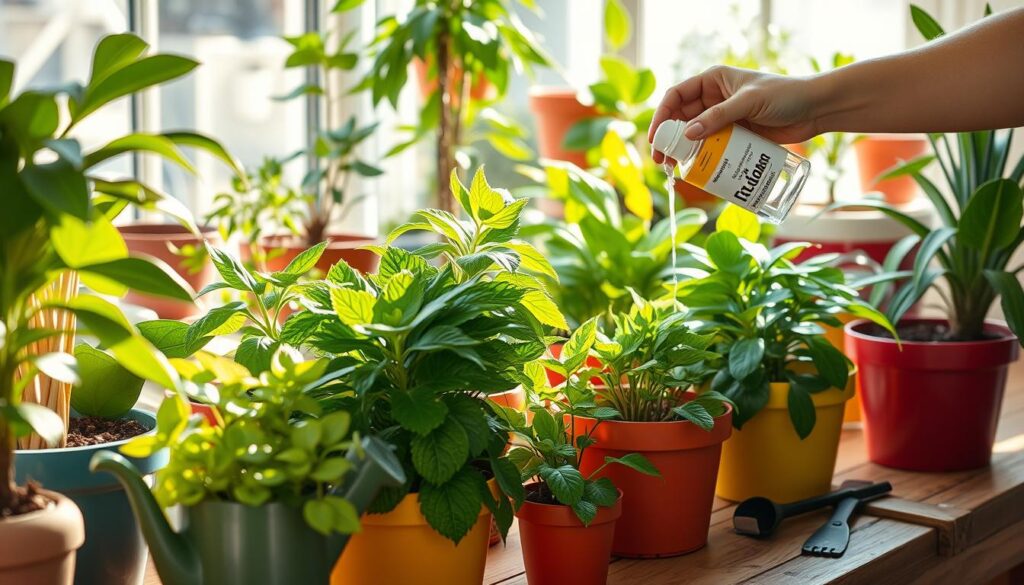
Dealing with Common Houseplant Pests
Keeping houseplants healthy and thriving is rewarding, but it comes with challenges. One big issue is pests. Pests like spider mites, mealybugs, and aphids can quickly harm your plants if not stopped.
Identifying and Treating Pest Infestations
Checking your plants often helps spot pests early. Look for signs like discolored leaves, insects, or webs. If you find these, isolate the plant and treat it with organic solutions like insecticidal soap or neem oil.
- Mealybugs can lay up to 600 eggs in cottony masses, often under leaves or on stems.
- Aphids leave a sticky, sweet honeydew that attracts ants or lets sooty mold grow.
- Scale insects like the brown soft scale can mature in about 65 days and reproduce in different ways.
- Spider mites appear as dark specks on leaves, and their webs show they’re there.
Stopping and managing pests is key to keeping indoor plants healthy. With careful watching and the right treatments, you can keep your houseplants safe from pests. This way, you can enjoy lush, green plants all year.
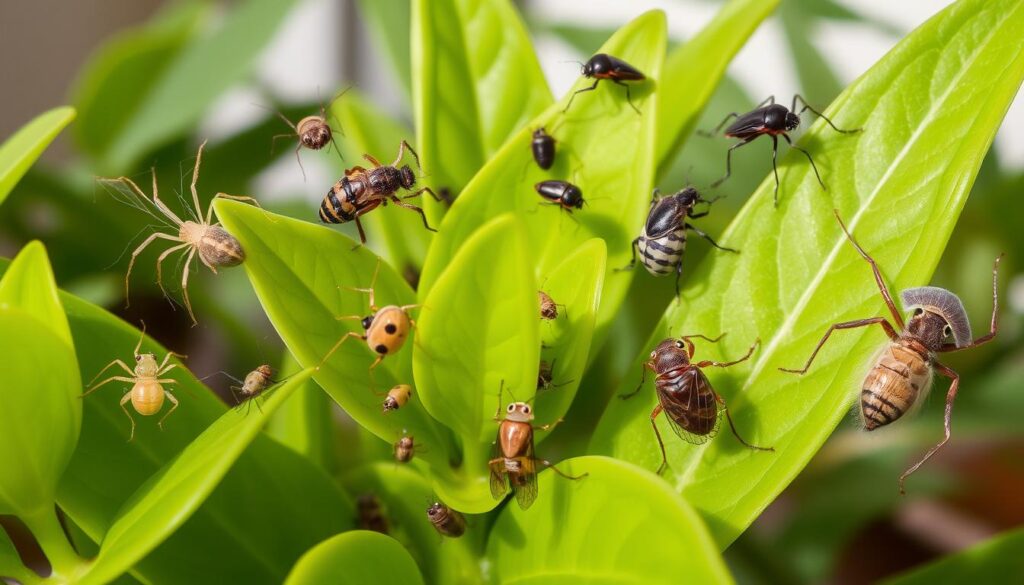
“The key to controlling houseplant pests is early detection and swift action. Regular plant inspections and the use of organic pest control methods can go a long way in keeping your indoor garden pest-free.”
Complete Guide to Caring for Your House Plants
Caring for indoor plants is more than just watering and feeding them. To keep your houseplants healthy, make sure they have the right soil, temperature, and air flow. Regular care like grooming and repotting is also key for keeping your plants looking great.
Providing the Right Growing Conditions
Houseplants need different amounts of light. Some do well in bright sunlight, while others prefer less light. Make sure your plants get the right amount of light. If there’s not enough natural light, use artificial lights to help them.
Watering your plants right is crucial. Improper watering is the No. 1 cause of houseplant damage and premature death. Know when to water more or less. Using Pennington Rejuvenate Premium All-Purpose Potting Soil Mix makes feeding your plants easy for up to six months.
Grooming and Repotting Houseplants
Keep your indoor plants tidy with regular pruning and cleaning. Signs of a healthy plant include normal-sized growth, well-formed leaves or buds, well-anchored stems, and good color and appearance. When plants outgrow their pots, it’s time to move them to a bigger one. Pennington Ultra Grow Potting Soil Mix is great for this, made with ingredients like Canadian sphagnum peat moss and earthworm castings.
By taking care of all aspects of houseplant care, you can create a beautiful indoor space. This includes giving them the best growing conditions, grooming, and repotting them when needed. This way, your home will stay bright and lovely for a long time.
Creating a Houseplant Oasis: Tips for Success
Turning your living space into a lush, green oasis is a great way to make your home look better and breathe easier. By picking the right containers and decor for your plants, you can make a beautiful indoor garden. This garden will not only look great but also grow well.
Choosing the Right Containers and Décor
The pots you pick for your indoor plants matter a lot for their look and health. Choose pots that match your plants and your home’s style. You can use ceramic, terracotta, or even old vintage pots to make things more interesting. Add to your plants with things like decorative pedestals or hanging planters to make the space feel welcoming.
Grouping Plants for Optimal Growth
Putting your houseplants together in groups helps them grow better and makes caring for them easier. Group plants that need the same light, water, and humidity together. This makes caring for them simpler and looks better. Try different heights, textures, and colors to make your indoor garden more interesting.
With these tips, you can turn any room into a lush, inviting place filled with healthy, beautiful plants. A little creativity and focus on details can make a stunning houseplant oasis. This oasis will make your living space feel better and improve the air quality.
“Houseplants have the power to transform a space, adding depth, texture, and a sense of life to any room. By carefully curating your indoor garden, you can create a truly remarkable oasis that uplifts the senses and nourishes the soul.”
Conclusion
In this guide, we’ve covered all you need to know about houseplants and creating a green oasis indoors. You now know how to handle light, water, pests, and nutrition for your plants. With these expert tips, you’re set to become a confident plant parent.
This guide is great for both new and experienced plant lovers. It gives you the key info to make your houseplants thrive. You can pick the right plants for your space, like Echeveria, Aloe Vera, and Sedum, or go for easy-care options like the Snake Plant and Pothos.
Now, it’s time to let your indoor garden bloom! With the tips and resources from this summary of the houseplant care guide, you’re all set. Create a lush, healthy, and beautiful indoor oasis. Enjoy the many benefits these plants bring to your home.
FAQ
Q: What are the key factors to consider when caring for houseplants?
A: When caring for houseplants, consider these key factors:- Know the plant’s light needs- Water it right, avoiding too much or too little water- Keep humidity at the right level- Feed it with the right nutrients- Watch for pests and treat them- Make sure it has the right conditions, like temperature and air flow
Q: How do I determine the right light level for my houseplants?
A: To find the right light for your houseplants, check if they like bright sunlight, partial shade, or low light. Use artificial lights like LED “grow” bulbs if your home lacks enough natural light.
Q: What is the proper way to water my houseplants?
A: Water your houseplants by checking the soil moisture. Water when the top inch or two feels dry. Don’t follow a set schedule, but check each plant. Water slowly until it drains, then let the excess go.
Q: How do I increase humidity for my indoor plants?
A: Boost humidity for your plants by misting them, using pebble trays, or placing them close together. Watch for signs like curled or brown leaves and adjust the moisture as needed.
Q: How often should I fertilize my houseplants?
A: Fertilize your houseplants every 2-4 weeks when they’re growing. Use a balanced fertilizer or slow-release granules. But don’t overdo it, as too much can harm your plants.
Q: How do I identify and treat common houseplant pests?
A: Check your plants for pests by looking for signs like discolored leaves or insects. If you find pests, isolate the plant and use organic treatments like insecticidal soap or neem oil.
Q: What other factors are important for keeping my houseplants healthy?
A: For healthy houseplants, also consider:- The right growing media and temperature- Good air circulation- Regular grooming like pruning and cleaning leaves- Repotting when necessary






